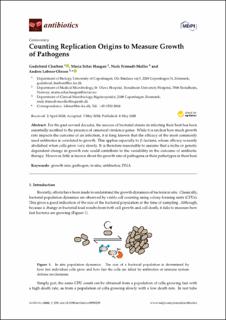| dc.contributor.author | Charbon, Godefroid | |
| dc.contributor.author | Haugan, Maria Schei | |
| dc.contributor.author | Frimodt-Møller, Niels | |
| dc.contributor.author | Løbner-Olesen, Anders | |
| dc.date.accessioned | 2022-11-28T14:31:15Z | |
| dc.date.available | 2022-11-28T14:31:15Z | |
| dc.date.created | 2021-02-08T11:04:03Z | |
| dc.date.issued | 2020 | |
| dc.identifier.citation | Antibiotics 2020, 9(5), 239 | en_US |
| dc.identifier.issn | 2079-6382 | |
| dc.identifier.uri | https://hdl.handle.net/11250/3034565 | |
| dc.description.abstract | For the past several decades, the success of bacterial strains in infecting their host has been essentially ascribed to the presence of canonical virulence genes. While it is unclear how much growth rate impacts the outcome of an infection, it is long known that the efficacy of the most commonly used antibiotics is correlated to growth. This applies especially to β-lactams, whose efficacy is nearly abolished when cells grow very slowly. It is therefore reasonable to assume that a niche or genetic dependent change in growth rate could contribute to the variability in the outcome of antibiotic therapy. However, little is known about the growth rate of pathogens or their pathotypes in their host. | en_US |
| dc.language.iso | eng | en_US |
| dc.publisher | MDPI | en_US |
| dc.rights | Navngivelse 4.0 Internasjonal | * |
| dc.rights.uri | http://creativecommons.org/licenses/by/4.0/deed.no | * |
| dc.title | Counting Replication Origins to Measure Growth of Pathogens | en_US |
| dc.type | Peer reviewed | en_US |
| dc.type | Journal article | en_US |
| dc.description.version | publishedVersion | en_US |
| dc.source.volume | 9 | en_US |
| dc.source.journal | Antibiotics | en_US |
| dc.source.issue | 5 | en_US |
| dc.identifier.doi | 10.3390/antibiotics9050239 | |
| dc.identifier.cristin | 1887546 | |
| cristin.ispublished | true | |
| cristin.fulltext | original | |
| cristin.qualitycode | 1 | |

